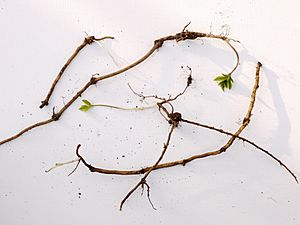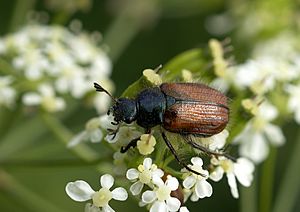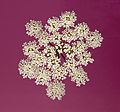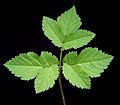Ground elder facts for kids
Quick facts for kids Ground elder |
|
|---|---|
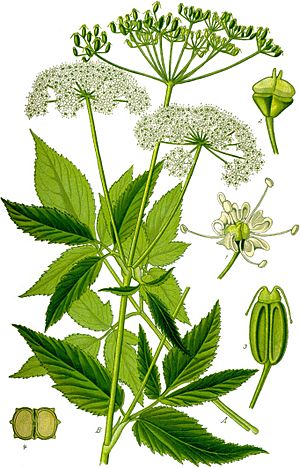 |
|
| Illustration from Otto Wilhelm Thomé's Flora von Deutschland, Österreich und der Schweiz (1885) | |
| Scientific classification | |
| Genus: |
Aegopodium
|
| Species: |
podagraria
|
| Synonyms | |
|
|
Ground elder (scientific name: Aegopodium podagraria) is a common flowering plant. It belongs to the carrot family, called Apiaceae. This plant often grows in shady spots. Its name "ground elder" comes from how its leaves and flowers look a bit like the elder plant. But they are not closely related! People also call it herb gerard, bishop's weed, or goutweed. It is originally from Europe and Asia. However, it has been planted in many other parts of the world. Sometimes, it can become an invasive plant, meaning it spreads too much and can harm local plants.
Contents
What Ground Elder Looks Like
Ground elder is a herbaceous perennial plant. This means it has soft stems (not woody like a tree) and lives for more than two years. It can grow up to 100 centimeters (about 3 feet) tall. It spreads using underground stems called rhizomes.
Its stems stand straight up, are hollow inside, and have grooves. The leaves at the top of the plant are divided into three parts and have jagged edges.
Ground elder flowers in spring and early summer. Its many small white flowers grow in a special shape called a compound umbel. This looks like an umbrella with many smaller umbrellas (called umbellets) branching off. Each small umbellet has 15 to 20 tiny stems, and each stem has one small white flower with five petals. Many different insects visit these flowers to collect pollen.
Later in summer and autumn, the plant produces small fruits. These fruits have long, curved parts called styles.
Where Ground Elder Grows
Ground elder is very common in the mild climate areas of western Asia and all across Europe. It has also been brought to other places, like Ireland, the United Kingdom, the United States, Canada, Australia, New Zealand, and Japan.
Why Ground Elder Can Be a Problem
Ground elder can spread very easily, especially through its underground rhizomes. Even though its seeds don't usually spread far, the plant can quickly cover large areas. Once it starts growing, it competes strongly with other plants, even in shady places. This can reduce the number of different plants growing there. It can also stop young trees and bushes from growing.
Because its seeds don't travel far, ground elder usually spreads to new areas when people plant it. This happens when it's used as an ornamental plant (for decoration), a medicinal plant, or a vegetable. It can also spread if garden waste containing its rhizomes is dumped. It grows very fast when conditions are good. Because of this, many gardeners consider it a "nuisance" or one of the "worst" weeds in flower gardens.
Ground Elder as an Invasive Plant
Ground elder has been introduced to many parts of the world, including North America, Australia, New Zealand, and Japan. It often gets started and grows wild in cool, moist climates. It is known as an "aggressive" invader in places like the Great Lakes region of North America, Australia, and New Zealand.
This plant can be a threat to the environment because it spreads so much. It can push out native plant species that naturally belong in an area. Because it can harm local plant communities and is hard to control, some places have banned or restricted its sale. This includes states in the USA like Connecticut, Massachusetts, Wisconsin, and Vermont.
Controlling Ground Elder
Once ground elder starts growing, it is very hard to get rid of. Even a tiny piece of its underground stem (rhizome) left in the soil can quickly grow into a new plant. The all-green type of ground elder might be even harder to control than the types with patterned leaves. Also, the all-green wild forms can grow back from seeds of the patterned varieties.
Trying to control ground elder in a garden by combining weed killers with landscape fabric, bark mulch, and hand weeding often doesn't work well. This is because new plants can sprout from any rhizomes or root pieces left in the soil.
Pulling, raking, and digging up the plants by hand can work. But you must be very careful to remove every single piece of the rhizome and root system. Removing the flowers before they make seeds can help stop the plant from spreading more. Ground elder uses up its stored food (starch) in the spring. So, removing its leaves in spring might help weaken the plant. After you remove ground elder, you should check the area carefully for a few years. Any new shoots that appear should be dug up and destroyed. It's a good idea to plant other things in the area afterward.
Stronger weed killers, like glyphosate, are often suggested. This is because ground elder will simply grow back if only its leaves are removed.
The best way to control ground elder is to stop it from growing in natural areas in the first place. It is recommended to plant ground elder only in gardens that are not next to wild areas. Also, plant it where its roots can't spread easily, like between a sidewalk and a house. However, because this plant is so aggressive, even this plan can be risky. Several states have banned the sale of ground elder (also known as bishop's weed).
Ground Elder as an Ornamental Plant
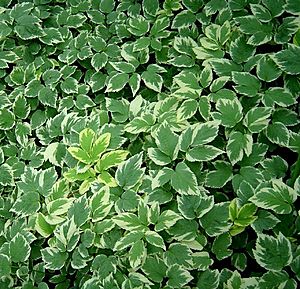
There is a type of ground elder with leaves that have different colors, called a variegated form. People grow this type as an ornamental plant because it looks pretty. However, as mentioned, it is banned in some states because it can spread too much. Seeds from the variegated form can sometimes grow into the more aggressive "green form" of the plant.
Ground Elder in Nature
In Europe and Asia, the young forms (larvae) of some moths use ground elder as a food plant. These include the dot moth, grey dagger, and grey pug. However, ground elder is not the only plant these insects eat.
Uses as Food and Medicine
In ancient times and throughout the Middle Ages, the soft, young leaves of ground elder were eaten as a spring leaf vegetable, much like spinach. It was often used in soups. The best time to pick the young leaves is from when they first appear (as early as February in the UK) until just before the plant flowers (May to June). If picked later, the leaves can taste strong and might act as a laxative. However, you can stop the plant from flowering by pinching off the flower buds. This helps the plant stay edible if you use it in smaller amounts.
Ground elder also had a history as a medicinal herb. People used it to treat gout and arthritis. They would boil the leaves and roots together and apply them in hot wraps to the affected areas. When eaten, the leaves were thought to help the body get rid of extra water (a diuretic effect) and act as a mild calming agent. Its use as a medicine has mostly stopped in modern times.
It is believed that the Romans brought this plant to Great Britain to use as food. Monks are thought to have brought it to Northern Europe as a medicinal herb. You can still find patches of ground elder growing around many old monastery ruins in Europe. Writings from monks, like Physica by Hildegard von Bingen, describe its uses.
Gallery
See also
 In Spanish: Aegopodium podagraria para niños
In Spanish: Aegopodium podagraria para niños


